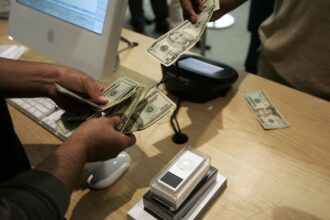Bank crises have been around as long as banks have been in existence. The classic Christmas movie, It’s a Wonderful Life, is the easiest way to understand the concept. Banks, in their simplest form, take in deposits and then make loans with that money. The bank earns the difference between the interest it pays depositors and the rate charged on loan, less any losses if borrowers don’t repay the loan. Like the Bailey Brothers Building and Loan, all banks don’t have the cash available to repay depositors if a large number want to make withdrawals simultaneously, also known as a run on the bank. Even otherwise solvent banks can be destroyed by a crisis of confidence. For this reason, the government created various programs, including capital requirements and FDIC insurance, to bolster confidence in the banking system.
The epic collapse of Silicon Valley Bank (SIVB
VB
Another impact of the banking crisis has been the plunge in government bond yields. The flight-to-safety response has sent Treasury yields rapidly lower from recent highs, especially for short maturities.
Bank regulators and investors use Common Equity Tier 1 (CET1) to measure the amount of bank capital available to absorb losses. The higher the CET1, the better. In addition to making loans, banks invest the depositors’ cash in securities in two buckets, available-for-sale (AFS) and hold-to-maturity (HTM). These buckets are essential because AFS securities are shown at market value, but HTM is accounted for at amortized cost. This distinction is crucial because the 10-year Treasury yield had risen from 0.5% in August 2020 to 4.1% in March 2023, leaving most bank HTM bond portfolios with significant unrealized losses not reflected in the bank financial statements.
When the Silicon Valley Bank’s data is adjusted for the losses in its HTM portfolio, it only had a sliver of its capital left, which still doesn’t account for possible losses from its loan portfolio. Unlike Silicon Valley Bank, the average large regional banks and Global Systemically Important Banks (G-SIBs) have a robust capital cushion, even after accounting for securities’ losses. The primary U.S. G-SIBS are JP Morgan (JPM), Bank of America
BAC
C
WFC
BK
MS
Following the collapse of Silicon Valley Bank, the Federal Reserve announced a new facility to help banks meet withdrawal requests from depositors and restore confidence. The Bank Term Funding Program (BTFP) allows banks to borrow up the face value of any government bonds held in the bank’s portfolio at a very reasonable rate.
Another challenge for Silicon Valley Bank was the inordinate size of its securities portfolios relative to deposits. This divergence from typical regional banks is vital in the current environment because rising yields led to massive losses in its bond portfolios.
It is also important to note that only 3% of Silicon Valley Bank’s deposits qualified for FDIC insurance. According to Goldman Sachs, Silicon Valley Bank’s average account size was $1,251,000 versus $177,000 at the average regional bank. The sizeable average account size is important because once those large accounts become fearful, they have a strong incentive to flee since most of their account value could be lost in a bank failure as it is above the FDIC limit. In a significant change from the Bailey Brothers days, depositors no longer need to line up outside the bank to move their money. It only takes a few clicks to add to the pressure of a bank run.
Despite the current crisis, the U.S. banking system sits at a multi-decade high capital level. While rising yields and fluctuations in the economy have exposed the weaknesses of some banks, the banking sector does not look to be at a high risk of systematic failure or collapse.
This week the Federal Reserve (Fed) meets on Wednesday and remains likely to raise interest rates again to combat inflation. The difference is that in the wake of the crisis of confidence in the banking system, the Fed should only increase short-term interest rates for 25 basis points (0.25%) rather than the not-insignificant odds of a 50 basis point hike before the Silicon Valley Bank debacle. Some even believe the Fed won’t hike at all this week. The one-year forward Fed funds futures rate now reflects expected rate cuts beginning this summer and the increased odds of a recession in the wake of the pressure on the financial system.
In conclusion, the banking system will not likely make the U.S. devolve from Bedford Falls to Pottersville. Unlike the Global Financial Crisis, the current banking challenge looks like one of liquidity for most banks rather than an issue of solvency. This likely eventual happy ending does not mean there won’t continue to be particular pressure on some of the banks perceived to be weaker by the markets. Investors would be wise to know what they own when investing in the financial sector. In addition, any continuing turmoil within the banking system will weigh on the overall market and the economic outlook.
Read the full article here










